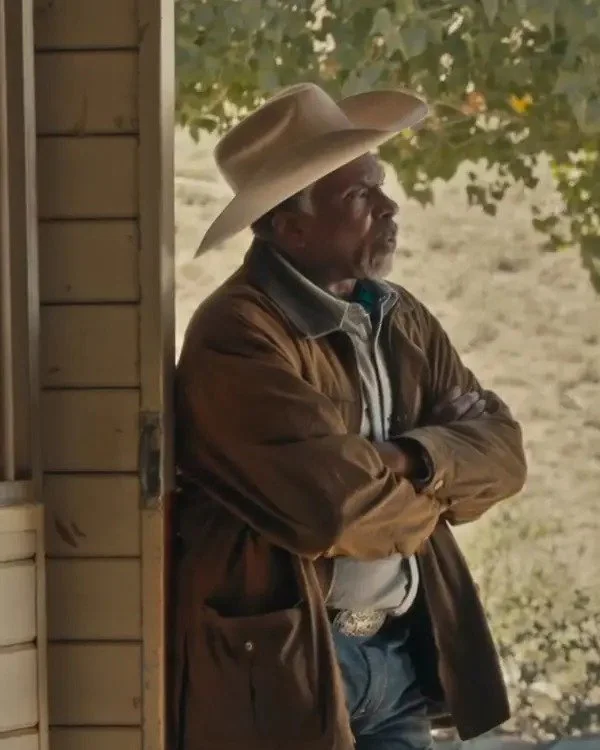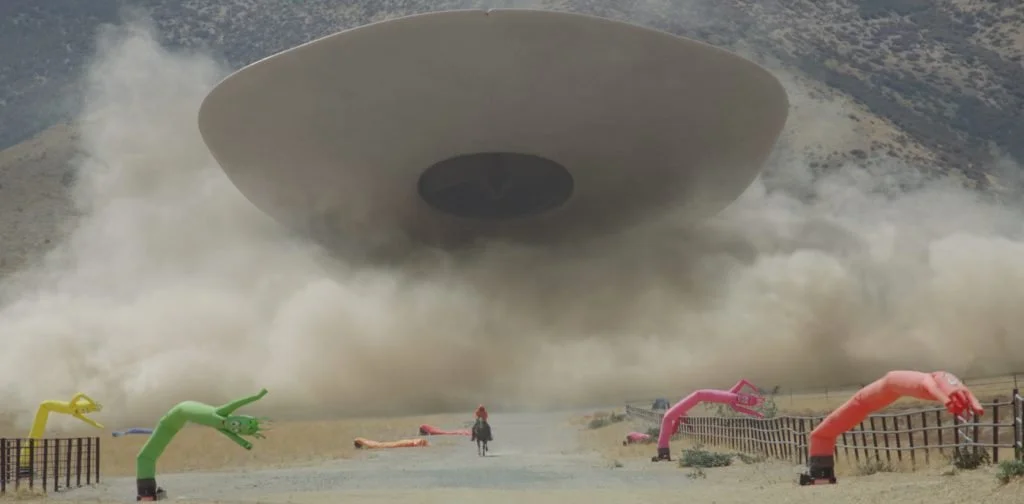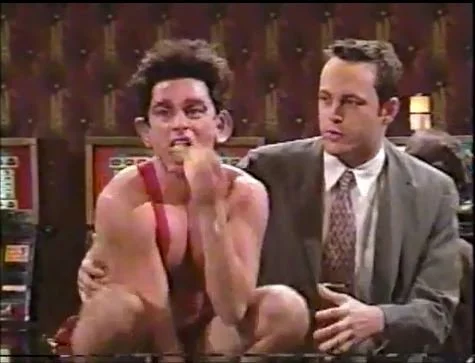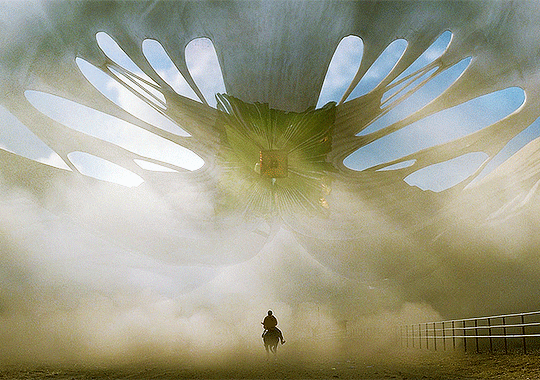On Nope (2022)
The title is the best possible response to just about any event in this movie.
A few weeks back, Edgar and I saw Jordan Peele's latest film, Nope, and I've periodically thought back over it in the intervening time. We've seen his run on the Twilight Zone, but missed his other films in the theater and it's almost impossible to find anything particular on streaming. We want to – while it hasn’t been as well-received, it seems, as Get Out or Us, I was very impressed by Nope.
For the record: spoilers follow. I don’t really care about spoilers, so I’m warning you now.
Also, for those sensitive to such things: there is a .gif file later on in this piece.
Let’s start with a summary of medium depth.
I’d watch this version of True Grit.
The film opens with a bizarre sequence involving a chimp (portrayed via motion capture by actor Terry Notary) on a television set set, surrounded by dead or grievously injured bodies, an applause sign visible behind him. The chimp looks into a camera, and it cuts to another scene.
The second scene involves an older black cowboy, Otis Heywood (played by the inimitable Keith David) speaking to his son, Otis “OJ” Jr. (played by Daniel Kaluuya) as they tend to their horses. OJ is training them, while Otis looks on, astride the white horse, ghost. After a conversation, debris begins to rain from the sky, and Otis is killed by a nickel piercing one eye.
The Heywoods, as is made clear by a speech given by OJ’s sister Emerald (Keke Palmer) in the next scene, have a long association with the cinema: they are descended from the black jockey featured in Eadweard Muybridge’s 1878 clip Horse in Motion, and have made their living as horse wranglers for the films ever since there was a Californian film industry.
An aside: there are many films out there about the power of cinema, the magic of the movies. It’s a cliché, and one that people in the film industry repeat often enough to make it sound as if they are trying to convince us. It’s almost as prevalent as books about the power of literature. While I’m occasionally a sucker for both, it really seems to me that most films (and most books) need to find a new angle and tread some new ground. The film industry and traditional publishing are both in trouble, and talking about their own power is a great way to not address that trouble at all.
Nope is not that kind of film, despite what it might seem, or what might be proposed in reviews and analyses of it.
Nope is about something else, separate but related.
Nope is a film about vision and image.
Of course, given how layered it is, and how many different themes show up over and over again, it would be foolish to say that it’s about any one thing in particular, instead of a variegated and overlapping panoply of themes. But chief among them, in my read, is the mental object that appears as image from one side, vision from another, and spectacle from a third.
Let’s stop with the granular examination: the Heywood ranch is failing. Partly, this is because OJ is not the businessman that Otis, Sr. was – and why would he be, he’s traumatized from seeing his father killed in a baffling way – but partly it’s because there’s an animal that looks like a UFO that’s eating his horses. I loved this twist: the UFO not as the artificial craft but as a hovering ambush predator that simply looks like a flying saucer (or, alternatively, an eye). To solve this, they intend to capture an image – preferably footage – of the creature and sell it.
There’s a problem, though: electronics fail in the creature’s presence. So the cameras they set up to capture movement fail when it approaches, necessitating house calls from UFO-true-believer (and anal-probe phobic) Angel, who works for the local big box electronics store.
Jupe (Steven Yeun) refers to the satire of his childhood trauma as featuring Chris Kattan (pictured above) playing the chimp. Given that Kattan played a chimp-like creature called “Mr. Peepers” in a number of sketches ,this rings true.
Second problem: they’re not the only people who saw it. Their neighbor, Ricky “Jupiter” Park, former child star and owner-operator of the Jupiter’s Claim theme park, has also seen it, and believes it to be a UFO operated by beneficent aliens he calls “Viewers”, who abduct his horses (in reality, the animal has simply been eating the horses – bought from the Heywoods, and which OJ intends to buy back at some point – that he releases to attract it). Jupiter is an interesting character, because he is the viewpoint character of the opening shot, and he recounts the chimp’s brutal massacre of his costars on the ill-fated show Gordy’s Home through the lens of the Saturday Night Live sketch about it. This is a man so alienated from himself, so unable to touch his most traumatic memory, of looking into the eyes of a creature that he watched commit brutal violence, that he can only approach it third-hand, recounting the satirical recapitulation of it instead of the actual event.
There are many points in the film where the themes of vision and image pop up. The monster of the film, called “Jean Jacket” by the Heywoods, after a horse they once owned, resists being translated into image or spectacle. Any attempt to do so fails until they manage to recruit veteran cinematographer Antlers Holst (Michael Wincott) to do so with an antique film camera, only to have the (terminally ill? He was seen taking pills, so he’s either intended to be an addict, terminally ill, or both, I assume) Antlers take his camera and feed himself to the monster. The fact that it also almost scooped up Angel at the same time, but Angel protected himself by wrapping his body in barbed wire – thus becoming a metal implement to pierce the monster’s body, as he was worried invaders from beyond the stars would pierce his body with – struck me as a clever, if somewhat convoluted, reversal.
This incident prompts the monster to change, unfurling its body, revealing a jellyfish-like corpus with an ever-unfolding green square, like the aperture of a film camera made out of fern leaves. In short: just before the Heywoods manage to catch the image, the monster shifts from the shape of an eye (beholding) to the shape of a camera (capturing an image).
Neon Genesis Evangelion (previously mentioned here) was namechecked as a visual inspiration. You can see the influence.
Okay, you may ask, what does this mean?
Well, if I could tell you, I’d just be recreating the film Nope. If what was being said could be reduced down to a paragraph, the film wouldn’t exist. I can simply gesture at the meaning, and no more.
My guess, though, is that if I were to try to summarize what it meant, I would say that it’s about how vision – beholding, specifically, as I termed it a short time ago – is a part of the line between human and nonhuman. We talk about how the eyes are the window to the soul, but in the contact of one gaze to another, you have the feeling of intersubjectivity, the recursive beholding-and-awareness-that-you-are-beheld that loops endlessly between you and the other being you’re meeting eyes with. When confronted with an animal, this is often a slightly uncanny feeling: does that squirrel perceive me as a thinking being or as a threat? Some animals (elephants, crows, octopodes) clearly do, and we can tell based on their behavior and how they appear to look back at us in a way that suggests that they’re trying to guess what we’re thinking.
Think about how difficult it might be to read the signals of a clearly intelligent, well-known animal like a cuttlefish, now imagine trying to read a massive atmospheric predator of an unknown type. (image taken from wikipedia, © Hans Hillewaert, used under a CC BY-SA 4.0 license.)
When confronted with something as alien and surprising as Jean Jacket, what even is the eye? How does it perceive? How does it think? Can we actually make a guess as to what it might do? How well does it understand us?
One thing that OJ comes to conclude is that it views the image of an eye as a threat – being perceived sends the creature into a berserker rage. He uses this to lure the creature into a beautifully shot (both diegetically and extradiegetically) chase sequence. This could indicate that the film is trying to say something not about the power of cinema, but about its weaknesses. Perhaps what is being suggested here is that the real world is radically opposed to being reduced to spectacle, that there is always some toxic remainder of the real experience from the production of images that cannot be reduced, that is canceled out but preserved in the process as a ghost of its former self.
The real world resists being apprehended on our terms. It can only be met on its own terms, and a refusal to do so might result in a tragic and ultimately unnecessary loss.
Honestly, as brief as this piece is, I’m going to leave it at that. While there are other layers (the relation between human beings and wild animals is a rather rich one) I’m going to leave them to other people to explore.
※
If you enjoyed reading this, consider following our writing staff on Bluesky, where you can find Cameron and Edgar. Just in case you didn’t know, we also have a Facebook fan page, which you can follow if you’d like regular updates and a bookshop where you can buy the books we review and reference (while supporting a coalition of local bookshops all over the United States.) We are also restarting our Tumblr, which you can follow here.






